Music is the universal language
“Glory to God in the highest heaven, and on earth peace to those on whom his favor rests.” - Luke 2:14
General Interest
“I didn’t try to play a guitar hero solo, but it sounds like it” The Cult’s Billy Duffy reveals his ultimate guitar solo

When it comes to weird and wacky, off-the rails epic guitar solos, it’s hard to beat Billy Duffy’s wildcat lead on the Cult’s 1987 hit Love Removal Machine, from their Rick Rubin-produced album Electric. It’s big and bold in all the ways a rock solo should be, but it zigs where other solos zag. It simply doesn’t behave – there’s a messiness to it in ways that recalls Jimmy Page’s fireball solo to Led Zeppelin’s Heartbreaker.
“I take that as a compliment,” Duffy says. “Most people like it for what it is, but there were a few people who slagged it off.”
He points to one such criticism from a friend, Dweezil Zappa. “It was quite funny, actually,” he says. “We were backstage at some arena, and he went, ‘Dude, that solo is out of tune.’ I said, ‘I know.’ Dweezil was totally floored because he couldn’t comprehend why somebody would try and make a rock ’n’ roll record and not be as concerned with perfection and timing as they were with spirit and attitude.
“I mean, we were making a rock and roll record,” he continues. “We wanted something authentic, and we didn’t get caught up in details. That solo was okay with Rick Rubin, who as far as I know, is the coolest man alive. If Rick was fine with it, I was happy to let it stand.”
Peace Sells?
Originally, Rubin wasn’t tapped to produce the Cult’s follow-up to their breakthrough 1985 album, Love. The band had spent the better part of the summer of 1986 working with producer Steve Brown (who had produced Love) at the Manor Studio in Oxfordshire recording an album to be called Peace that sound-wise (lots of guitar effects, multiple layers of overdubs) didn’t stray from hits like She Sells Sanctuary and Rain.
“The general idea was that Love had been a hit and we became a known band, so logically we didn’t want to completely change course,” Duffy says. “We were just looking to add a bit more muscle to our sound and rock more. We had already done punk rock, which became a bit restrictive, so now it was the mid-‘80s and we thought, ‘Maybe we should explore early Zeppelin.’”
Before sessions with Brown had commenced, however, the band hit a bit of a snag when, as Duffy recalls, singer Ian Astbury, had “a bit of an episode.” “It was sort of a creative crisis that led to a blowout in Italy in which Ian threw out his lyrics,” Duffy says. “We went into the studio without spending much time on the music. Ian wasn’t engaged enough, and we overcompensated with production and layering. There were too many guitars, but that was just how I normally do things. I write melodies by layering guitars.”
Dissatisfied with the results, the band decided to contact the New York-based Rubin, who had already established himself as a shining star by combining rock and hip-hop on hits by the Beastie Boys and Run-DMC (particularly their rock-rap mash-up Walk This Way with Aerosmith), and have him remix Love Removal Machine, which had already been viewed as a potential single.
Idle Hands
Rubin made his feelings known to the band in no uncertain terms. “He thought what we recorded was too busy,” Duffy says, “Although his actual words were less PC. He thought it was too messy and complicated. It didn’t hit hard enough for him. He wanted something simple and direct.”
Before remixing Love Removal Machine, however, Rubin made the proviso that he would do so only if he and the band would recut a song they liked the least on the record, Peace Dog. After doing so, the decision was quickly made to toss away all existing tracks and redo everything, with Rubin producing the band as he saw fit.
“Rick talked about AC/DC, Zeppelin and a little bit about Aerosmith,” Duffy says. “He asked, ‘Do you like those records?’ and we said, ‘Hell yeah.’ I saw AC/DC when Bon Scott was in the band, so I was very much on board. At that point, we were open to somebody who had a different vision. We weren’t precious about things at all. Rick made a lot of sense to us, and he took us on a bit of a journey. He later said something once that I quite liked – that he didn’t so much produce the Cult as he reduced us. In that way, Electric is sort of an outlier for me.”
The band traveled to New York to work with Rick. You recorded at Electric Lady Studios.
“Right. We were in the big studio downstairs – in the back of my mind, it’s where AC/DC did Back in Black. Rick had a great team – Andy Wallace was the engineer, and George Drakoulias was there. Rick had the vision.”
Rick hadn’t yet worked with a lot of full bands.
“This might have been before he produced Slayer – I’m not sure. He was very confident, but in a nice way. He believed in what he felt. He believed in the band. He got us.”
As a guitar player who had established a sound, was it hard for you to give in to Rick’s approach and let go of your effects?
“Sure. It was quite a shock. I don’t think anybody else realized or cared that I was literally flying by the seat of my pants. I was reaching back to being a teenage boy, pre-punk, listening to Mott the Hoople and Bad Company and Led Zeppelin, et cetera, et cetera. The other thing was, all the gear on Electric was rented – every stick of it.”
Before you did any recording, even for what was supposed to be the Peace album, did you play any of the material live, just to test it out?
“That’s a very good question, and I don’t think we did. No, wait – we played one song called Electric Ocean because we tried to cut it for a movie soundtrack. I know there’s a live version of it from a festival in Finland. But Love Removal, none of that was played live.
Set the scene in the studio. Rick tells the band, ‘Great song, but you’re doing too much. We’re gonna take it down to bare bones.’ Did he get you all there to rehearse as a band to make the song lean and mean?”
“Absolutely. Originally, it was three guys in the room – Ian wasn’t there because he didn’t sing with us when we were doing the backing tracks. But I remember Rick telling him, “You’re the singer, right? Go and sing!” Ian jumped in and we cut every track from the floor. Which was great because the singer is part of a team. The vocals are essential. If you’re taking away all of these guitar layers, you won’t be left with much if you don’t have any singing.”
As you mentioned, the gear was rented. That included your guitars?
“Yeah. There’s no Gretsch guitar on the song or the album, which will break everybody’s hearts. I used two rented Les Pauls.”
Your go-to guitar had been a Gretsch White Falcon. Did you feel naked without it?
“Absolutely. It was scary at first. Now, I should say that prior to the Cult, I had played Les Pauls. I got into Gretsches around 1981. So I’m playing Les Pauls through rented Marshalls – no delay or chorus or echo. I was used to having an overdriven sound, because the more saturation you have, the easier it is to play. Rick and Andy had this thing where they backed off the overdrive, and I was panicking a bit, but they found that if you backed off the gain, the amp sound became bigger. It was that sweet spot.”
Let’s get into that solo. Did you plot it out beforehand, or was it spontaneous?
“I’m a gut guy. I’ve always felt my role as a guitar player would be to serve the song, and playing a good guitar solo is part of that service. Because I had a punk rock background, I didn’t like perfection. I wanted soul, passion and guts.”
You start the solo out on this crying, sustained note. Did you at least have that planned?
“My thing with a guitar solo is, you need to know how you’re going to get in and how you’re going to get out. What happens in the middle isn’t quite as important. I did have the idea to start the solo because of a song called Violence by Mott the Hoople. There’s a break where Mick Ralphs hits a note with a wah-wah and he sustains the note while the music moved around it. I just always felt that the more you can say with the less notes, the better. There’s time to do a lot, and in some spots I went a bit mad. I was just trying to help out and do my job. It wasn’t like, ‘Hey, look at me!’”
Even so, it is a very “look at me” guitar solo.
“Well, it’s set up that way. It’s presented on a platter, isn’t it? It’s a bit of a pig with an apple in its mouth. Rick had us reconstruct the songs, and that was part of it – you needed the payoff.”
Did you play the solo live with the rest of the band?
“I honestly can’t remember how I did it. I don’t know whether I would’ve done a solo without rhythm guitar, if you know what I mean, because it would’ve just been drums and bass. It’s likely that I did it as an overdub. But the solos on that record were not really chopped together.”
The middle part of the solo – the part that Dweezil Zappa said was out of tune – it’s completely mad. It’s great, but it’s totally weird. What was running through your mind as you played it?
“I can’t recall. I wasn’t as caught up in the detail because it was a bit of a rush job. There was a lot of pressure because we knew we’d eaten up all the budget and we were on borrowed time. So my mindset was more like, ‘If everybody else is into it, I’m into it.’”
Toward the end of the song, the band goes into a full-tilt boogie and you do another solo – more of a spitfire run. None of that was on the earlier version you had cut.
“I think what had happened was, we were a live touring band and we were looking for a song to be a set ender, something quite dramatic. It was just one of those crazy “go for it” rock and roll solos. I always felt it was in the spirit of Toys in the Attic – this explosion of energy.”
After you had finished cutting everything and you listened to a playback with Rick, what were you thinking? After all, this was a pretty stark difference in the band’s sound.
“I was a little nervous. I was aware that it was certainly going to upset a bit of a gothic apple cart. But Ian was totally committed, while in the back of my mind it was like, ‘Wow, this is going to really upset people.’ With She Sells Sanctuary, I intuitively knew it was the right thing to do.”
“People are like, ‘Why don’t you make an album like that again?’ Well, because we’re not 25 anymore, living this young man’s pirate lifestyle. Electric is kind of a cartoon album of our lifestyle at that time, and it’s very important in that context. We were naive and having a lot of fun misbehaving. It was the soundtrack to sort of a misspent youth.”
There was Dweezil Zappa’s reaction, but as you said, you’ve heard the opposite from a lot of people.
“The general reaction to the Electric album is, it’s sort of a timeless rock sound. Warts and all, it’s honest. It’s a few blokes playing to their best of ability without a lot of smoke and mirrors. From Rick all the way down to the band and everyone involved, we put the hours in. We believed that good, honest rock had gotten a bit of trodden under foot with punk rock. We just believed in what we were doing.”
We should talk about the riff to Love Removal Machine. At any point, did anybody in the band say, “Oh, shit, this sounds a bit like Start Me Up”?
“No. That’s a very interesting question because it’s kind of haunted the track. Hand over heart, I never thought it was influenced by that at all. Now, does it sound like it? Well, yeah, I can see that. I didn’t know it the time. I know the version that I wrote didn’t sound like it. It wasn’t intentional.
“I don’t know where it came from. It certainly didn’t come from me owning an album with Start Me Up on it. I’ve never really owned a Stones album – I know that might horrify people. But they did write one of my favourite songs ever, Gimme Shelter. I was just never a Stonesy guy.”
The post “I didn’t try to play a guitar hero solo, but it sounds like it” The Cult’s Billy Duffy reveals his ultimate guitar solo appeared first on Guitar.com | All Things Guitar.
New Sounds For All Guitar Amp Modellers
MayFly Audio releases the Terrain Deluxe Harmonic Optical Tremolo

The Terrain Deluxe is a Harmonic Tremolo with Tap Tempo, featuring a high fidelity all analog signal path using LightDependent Resistors (LDRs) for modulation. The Harmonic Tremolo mode uses an electronic crossover to split the signal into high and low frequency components.These are modulated 180 degrees out of phase and then re-combined creating a wet, lush tone. Speaking of tone, theTone control pans between the high and low frequency signals, going from full treble to full bass and everything in between. In the unlikely event that you get tired of the beautiful Harmonic Tremolo there is a Normal / Harmonic mode switch. In Normal Mode the high and low components are modulated together creating a traditional tremolo sound.
There are Speed, Depth, and Gain controls, and a Waveform switch to select between square, sine, and triangle waveforms.The Tap Tempo foot switch works win conjunction with the Tempo Multiplier switch allowing you to create quarter note, eight note, and eight note triplet modulations by just tapping the base tempo. The two tempo LEDs above the footswitch flash together in for Normal mode and 180 degrees out of phase in Harmonic mode.Finally, there are two independent expression pedal inputs: one each for Speed and Depth.
• Harmonic Tremolo with Tap Tempo.
• High fidelity all-analog signal path using LDRs.• Speed, Depth, and Gain controls.
• Tone control that sweeps between high and low frequency signals (center is flat).
• Normal / Harmonic mode switch.
• Sine, Square, and Triangle waveform switch.
• Tap Tempo footswitch with Tempo Multiplier switch.
• Independent expression pedal inputs for Speed and Depth controls.
• Full bypass with Fail Safe® using relays.
• 9VDC, 80mA.
MAP price: $220 USD ($299 CAD).
StewMac Launches Guitar Pedal Line With Four Hot Models
Building on the foundation of the company’s acclaimed pedalkits, StewMac has introduced a line of ready-to-play, fully finished guitar effects pedals.
The newly launched models include StewMac’s four most popular pedal designs: the Sun Fuzz; Lightcycle Phasor II optical phaser; Two Kings Boost dual overdrive; and Ghost Drive transparent overdrive. Each pedal delivers classic tone at an incredible price.
Sun Fuzz
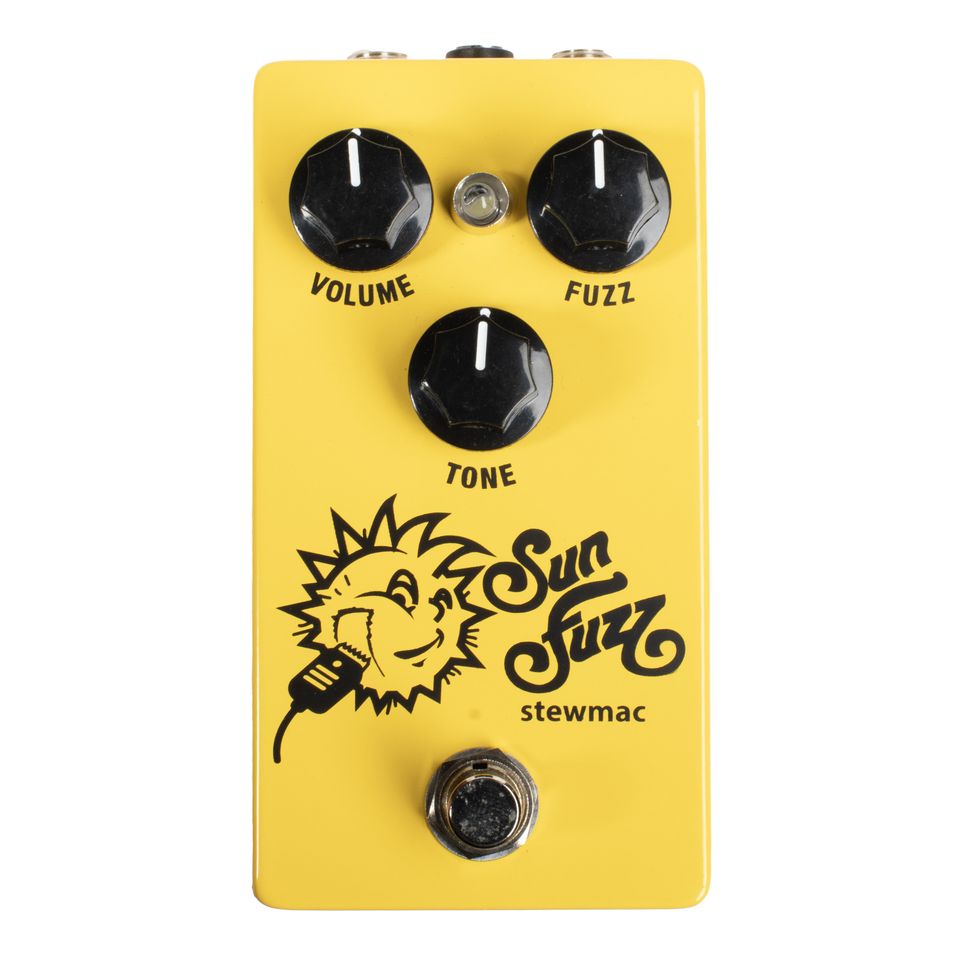
There have been countless replicas and reimaginations of the classic Fuzz Face pedal. StewMac’s Sun Fuzz gives you the control and tone shaping you've always wanted from the originals, and it’s a must-have for fans of Hendrix, Clapton, or Gilmour’s tone.
This circuit is one of the foundational tones for electric guitar, but the germanium powered originals can be hard to control and don't play nice with many pickups and amps—even temperature can completely change the tone! To create a more predictable, controllable, reliable tone, we've swapped the germanium transistor for a silicon BC-108, giving the pedal a brighter tone, more gain, and enhanced touch sensitivity.
Priced at $99.99, the Sun Fuzz is a no-brainer for fuzz fans who don’t want to shell out $200+ for the originals. Key features include:
- Improved bias control and tone shaping compared to the originals.
- Silicon BD-108 transistor.
- Versatile fuzz with simple controls for volume, fuzz, and tone.
- Sounds great with humbuckers, single-coils, and P-90s alike.
Two Kings Boost Dual Overdrive
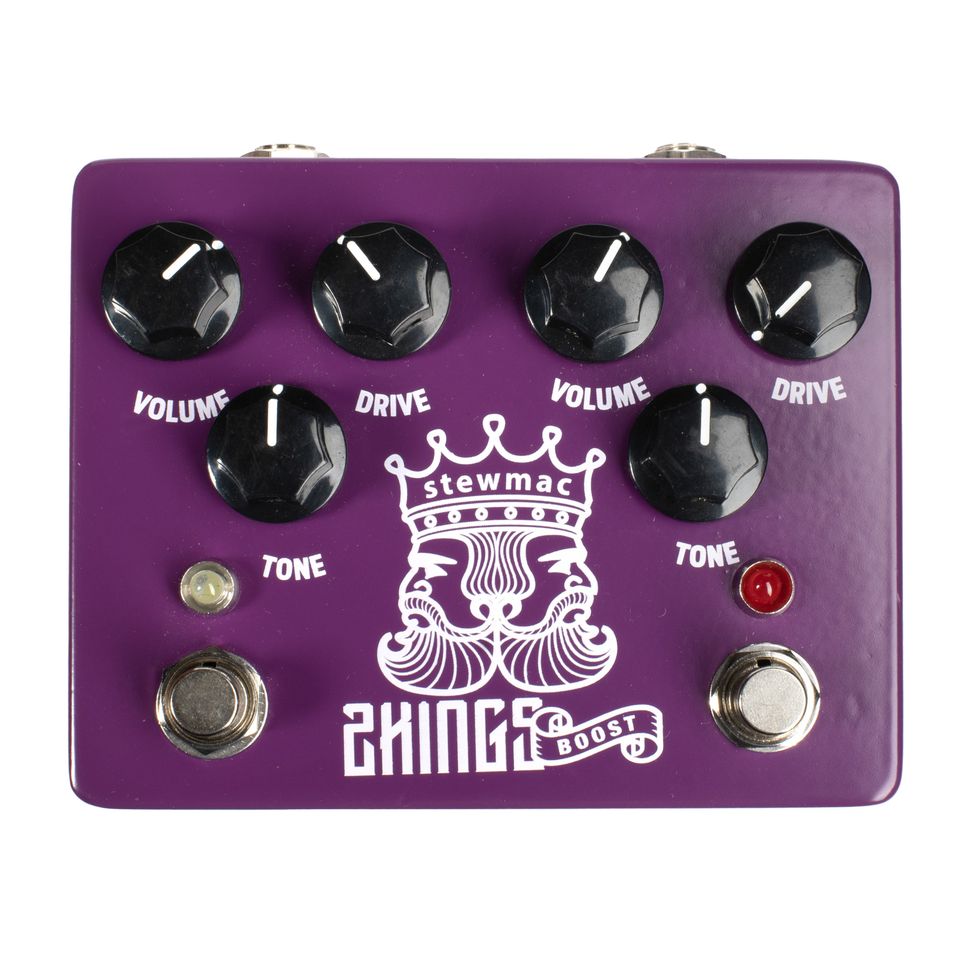
Inspired by one of the most sought-after dual overdrives on the market, players like John Petrucci, Gary Clark Jr., Samantha Fish, and Warren Haynes have raved about the originator of this circuit, the King of Tone. Now, you no don’t have to wait to add this circuit to your rig. StewMac’s Two Kings is transparent but still warm and gritty, with a full range of frequencies available—no matter the setting. It won't overpower the unique tone of your guitar and amp—it just makes it better.
The Two Kings is actually two pedals in one, with selectable boost and distortion through internal dip switches. The two sides of the pedal are completely independent—it's easy to find the sweet spot for each side. With knobs for gain, volume, and tone you can get anything from simple boost, gritty overdrive, and even distortion in a flash. If you want to go deep, you can further tailor the sound with the internal controls for infinite tone tweaking.
Priced at $199.99, the Two Kings is an affordable and authentic alternative to the pricey, hard-to-get original. Key features include:
- 2-in-1 pedal.
- Maintains core tone of guitar and amp.
- Effortlessly provides boost, gritty overdrive, and distortion.
Lightcycle Phasor II
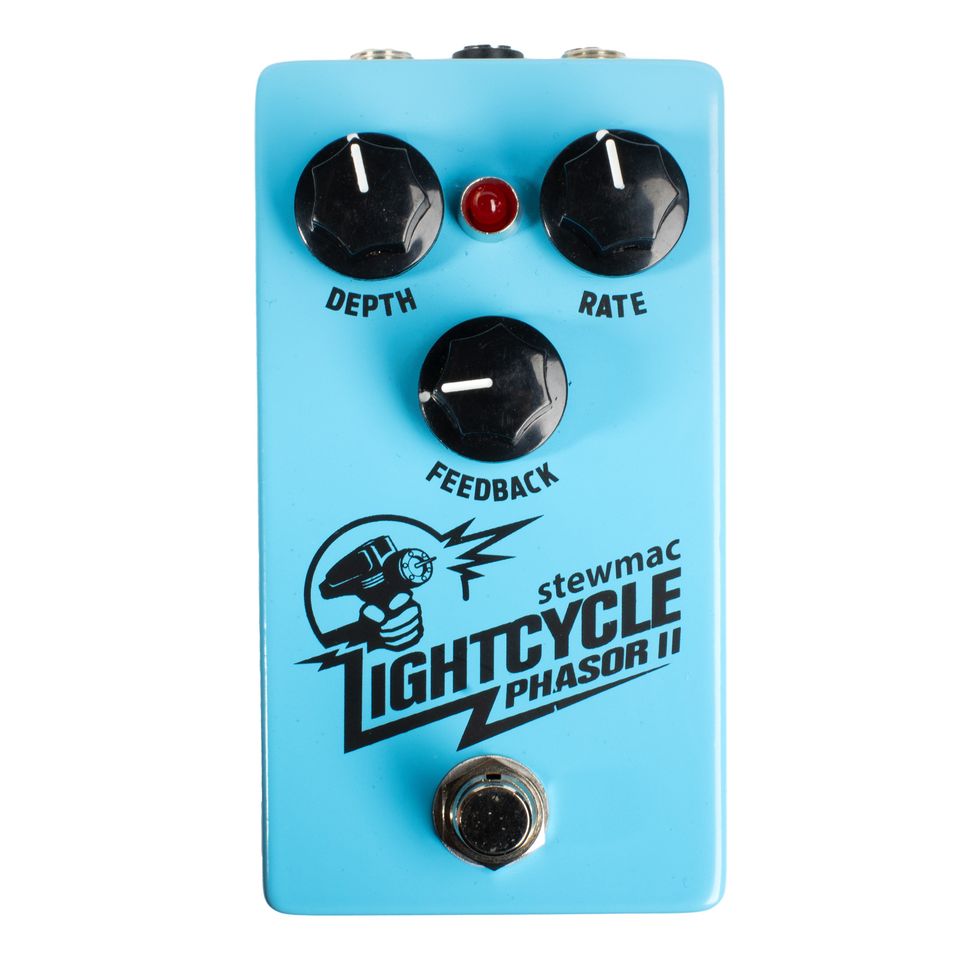
This isn’t just another phase shifter—it’s the unmistakable sound of deep, liquid movement that defined an era. Inspired by the MuTron Phasor II from the 1970’s this studio-quality, all-analog optical phase circuit set the gold standard for smooth, sweeping modulation. StewMac has recreated this timeless classic to bring your tone to life with the same lush, organic depth that graced the pedalboards of legends. You can recreate those complicated textures live—from a rotary speaker shimmer to wild spacey soundscapes, every knob twist sparks inspiration. On the front are controls for depth, rate, and feedback, letting you dial in anything from subtle swirl to rapid tremolo and synthesizer sounds. For even more flexibility, two internal controls let you dial in the sweep and intensity of the phased signal.
Priced At $149.99, the Lightcycle Phasor II is an authentic and affordable alternative to the original. Key features include:
- Studio-quality optical phaser.
- Controls for depth, rate, and feedback.
- Two internal controls to adjust the sweep and intensity of the phased signal.
Ghost Drive
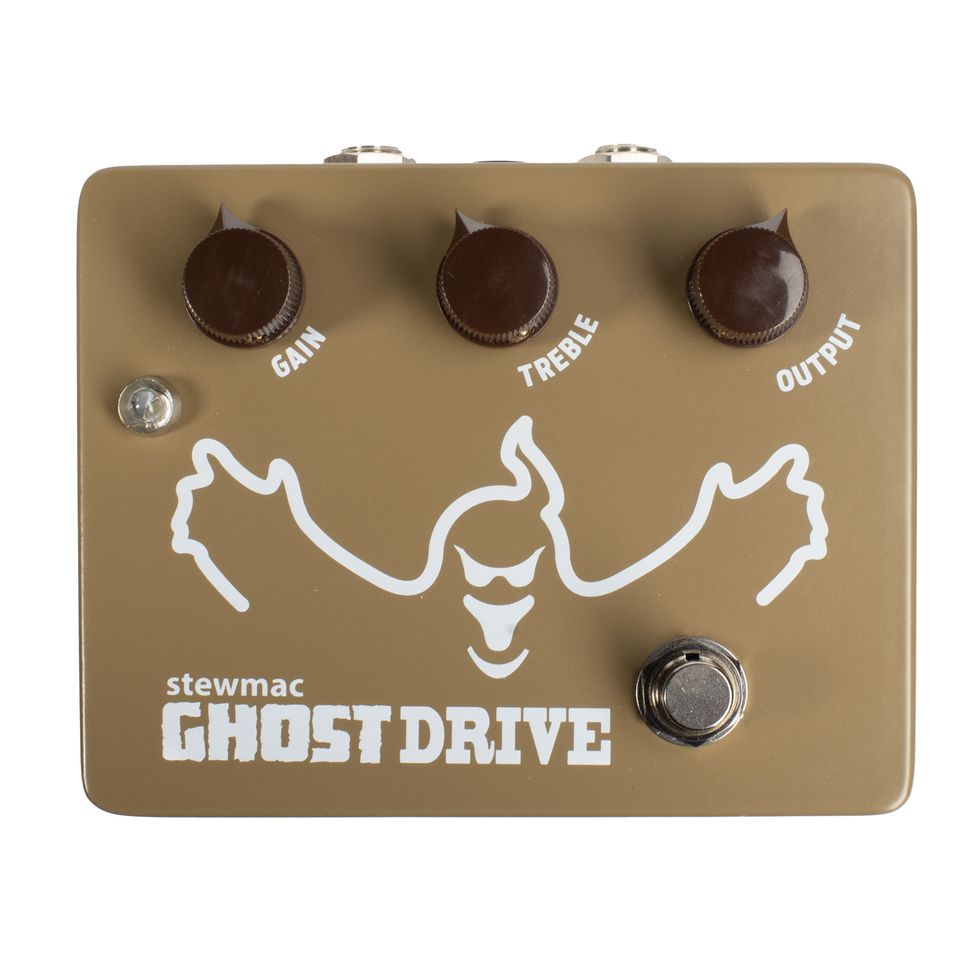
Not just another “klone”, the StewMac Ghost Drive pedal is the closest to the famed Klon Centaur Professional Overdrive we’ve ever heard. StewMac scoured the globe to source the nearly impossible to find (electronically identical) 1N34A germanium diodes that many claim were the heart and soul of the mojo behind the original Klon. Also, unlike so many modern klones that rely on surface mount components, the Ghost Drive is pure old school using through-hole components and traditional solder joints. This gives the pedal the purest tone possible and makes it a true match to the originals. The Klon was made famous by countless players like Joe Perry, Mike McCready, Joe Bonamassa, John Mayer, Nels Cline and more, but at more than $5,000 for a vintage original the StewMac Ghost Drive Pedal
This pedal is extremely easy to use: just gain, treble, and output. The gain is where the magic is by adding sweet saturation and harmonics while retaining the character of your amp. The treble acts as a boost or cut, allowing you to dial in the perfect mid-range for your tone.
Priced at just $149.99, the StewMac Ghost Drive provides a nearly identical tone for just a fraction of the price of the originals. Key features include:
- Through-hole components and traditional solder joints just like the originals.
- The electronic identical 1N34A germanium diodes in the originals.
- Works great as a clean boost as well as a transparent overdrive.
- Buffered bypass.
For more information about StewMac’s new line of pedals visit stewmac.com
Now Available: UAD Shadow Hills Mastering Compressor Class A and Maag EQ4 MS Plug‑Ins
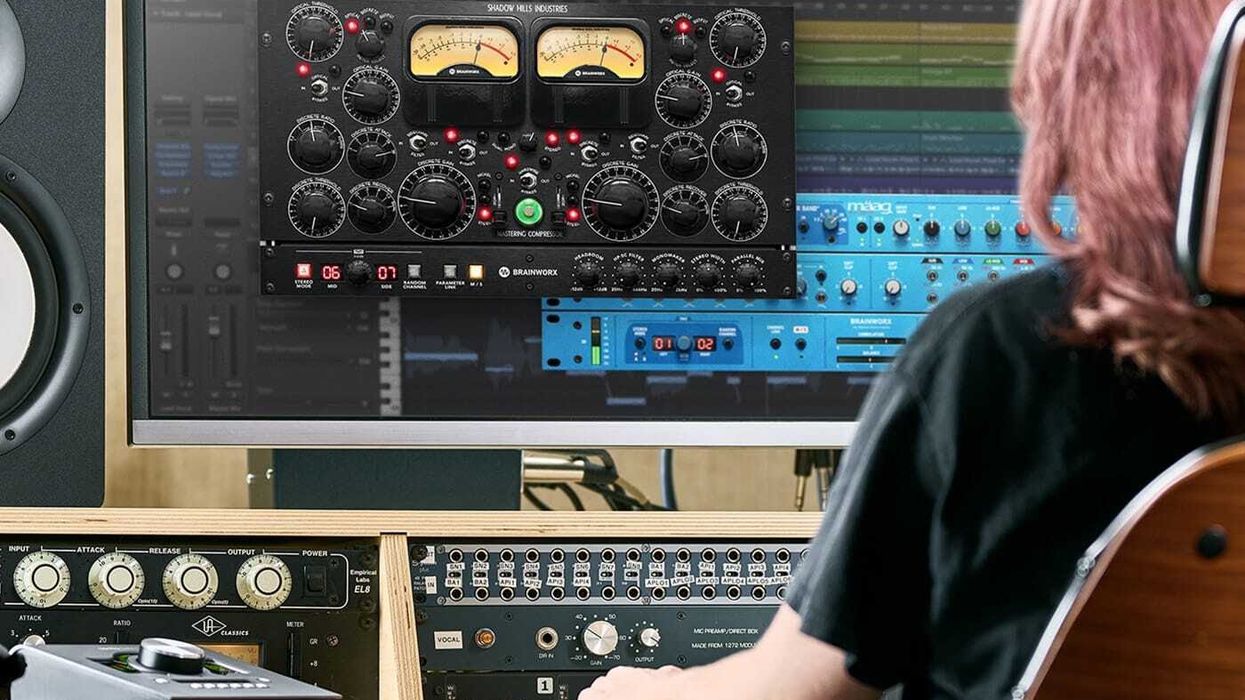
Universal Audio, a worldwide leader in audio production tools, today announced the release of the Shadow Hills Mastering Compressor Class A and Maag EQ4 MS plug‑ins. As a part of the Apollo and UAD v11.8 software update, these plug‑ins deliver enhanced sonics, with new features and workflows for modern music producers and engineers, or those looking to upgrade their current Shadow Hills or Maag plug‑ins.
UAD Shadow Hills Mastering Compressor Class A – $169 USD
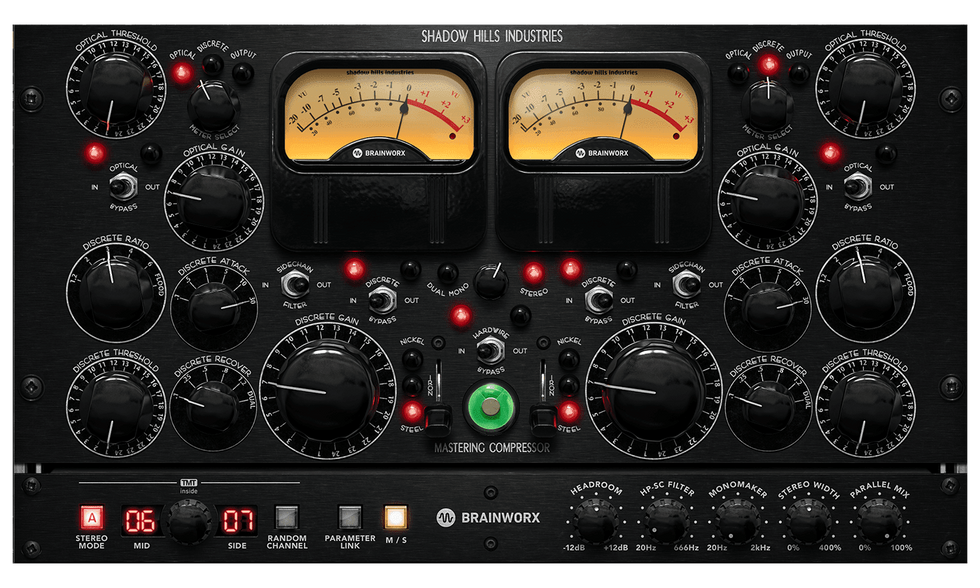
“Shadow Hills Class A and Maag EQ4 MS give music creators access to two rare and unique sounds in the UAD catalog,” says Lev Perrey, VP of Product at Universal Audio. “Beyond the updated UI, they add entirely new sonics and workflow capabilities, expanding what’s possible for customers working with Apollo interfaces and UAD hardware.”
The Shadow Hills Mastering Compressor Class A plug‑in is a meticulous emulation of the legendary “Red” edition hardware — of which only 50 units were ever built. It delivers the coveted dual‑stage optical and discrete compression stages, plus switchable Nickel, Iron, and Steel output transformers so you can dial in open and airy detail to thick, saturated tone.
Sonically enhanced with Tolerance Modeling Technology by Brainworx (TMT), the updated Shadow Hills UAD plug‑in features the subtle channel‑to‑channel variations of the real analog gear, giving mixes added depth and realism. Customers can also access powerful features including Mid/Side processing, Stereo Width control, Mono Maker, Parallel Mix, scalable UI, and more — going far beyond the original hardware.
Shadow Hills Mastering Compressor Class A - Key Features
- Updated version of rare Class A dual‑stage optical and discrete compressor plug‑in
- TMT technology by Brainworx adds subtle channel‑to‑channel variations for greater analog realism
- Switchable Nickel, Iron, and Steel output transformers for unique tone shaping
- Enhanced Class A circuitry with 1–3 dB hotter presence than the original UAD plug‑in
- Plug‑in only features: Mid/Side, Parallel Mix, Stereo Width, Mono Maker, Sidechain Filter
UAD Maag EQ4 MS — $129 USD
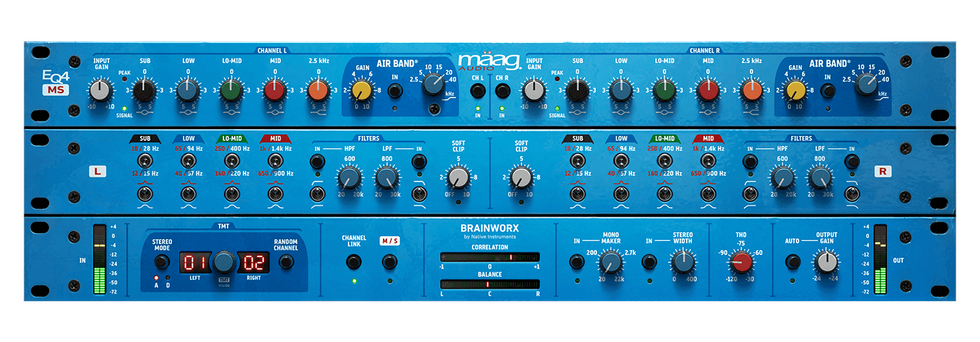
The Maag EQ4 MS plug‑in brings life to a classic UAD plug‑in title. Along with its iconic Air Band, the new version features Mid/Side processing, expanded frequency choices, selectable Q values.
Ideal for adding presence to vocals and instruments, the Maag EQ4 MS now brings extra clarity and depth to mixes thanks to TMT technology by Brainworx — which captures the real‑world channel variations that add analog realism unlike other matched digital EQs.
Maag EQ4 MS - Key Features
- Updated edition of the legendary EQ4 plug‑in with expanded sonics and flexibility
- TMT technology by Brainworx captures natural channel‑to‑channel differences for extra width and dimension
- Iconic Air Band delivers transparent, musical high‑end sheen for vocals and instrument
- Mid/Side processing tools for precise control of stereo image and depth
- Expanded frequency options and selectable Q values for refined tone shaping
Also included in the UAD v11.8.1 update, MIDI Learn is now available for all UAD DSP plug‑ins, giving customers hands‑on control of plug‑in parameters with compatible MIDI controllers. With a simple click, touch, move workflow, music producers working in Apollo studios with UAD plug‑ins can map knobs and faders in seconds — eliminating tedious menu diving.
Pricing & Availability
- The Shadow Hills Mastering Compressor Class A plug‑in is available for $169 (new customers) or $39 (upgrade price).
- The Maag EQ4 MS plug‑in is available for $129 (new customers) or $39 (upgrade price).
- Both plug‑ins, along with MIDI Learn functionality, are included in the Apollo & UAD v11.8.1 software update, available September 4, 2025.
Learn more about Shadow Hills Mastering Compressor Class A:
uaudio.com/products/shadow-hills-mastering-compressor-class-a
Learn more about Maag EQ4 MS:
uaudio.com/products/maag-eq4-ms
Learn more about UAD Plug‑Ins:
uaudio.com/collections/uad-plugins
Download images and press materials:
Vox V863-CA Review
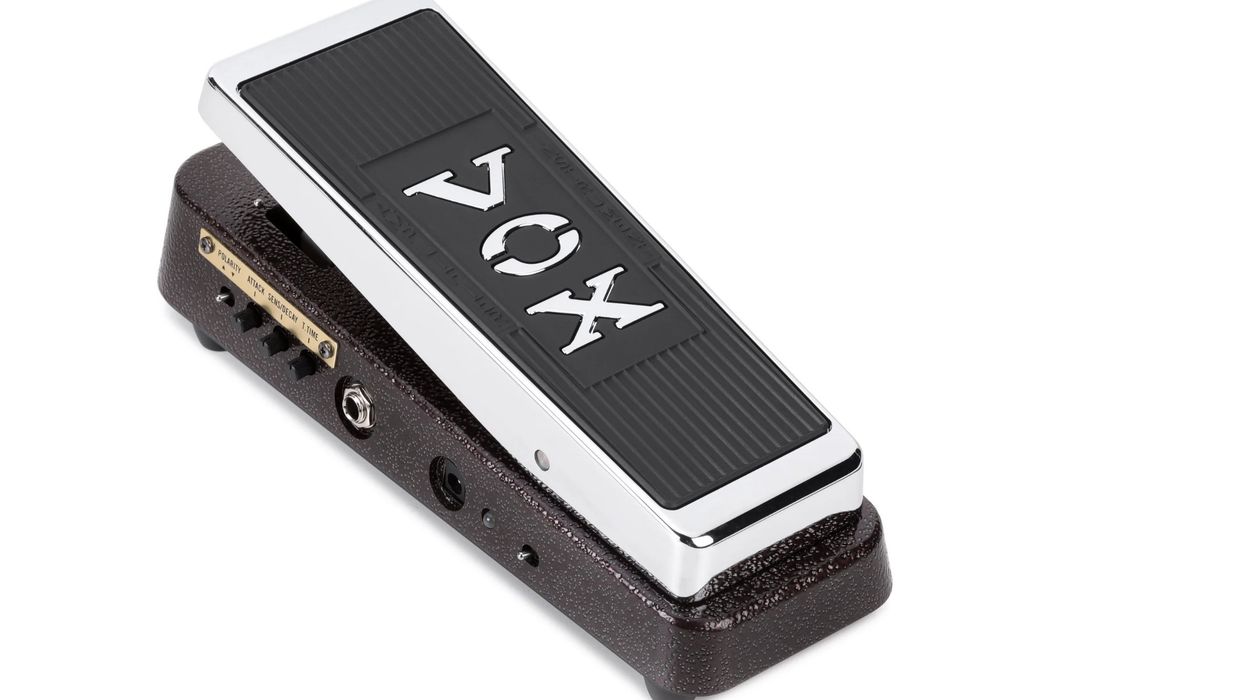
A 3-in-1 wah, envelope follower, and envelope controller that opens up a huge range of filtering possibilities.
As an avid—perhaps rabid—musical psychedelicist, I’ve had a lot of wah in my life. Maybe too much. In recent years, I seem to have had my own personal version of the rock world’s 1968 epiphany, where everyone ditched their wah and fuzz, moved to the country, and put Music from Big Pink on constant replay.
Recently, though, I’ve been in touch with my wah side again—this time by way of JJ Cale’s chilled out swells and Curtis Mayfield’s mellower wah flourishes. And through these applications of treadle-actuated filtering, I’ve rekindled my love for the more psychotic side of the effect. Vox’s V863-CA will happily wind along either the gentle path or the hard road. It has a nuanced filter taper that makes slow, focused sweeps sound sweet and vocal, and it responds to quick-twitch moves with precision. But the real magic in the V863-CA is its combination of envelope generator (auto wah) and envelope follower functions, as well as its ability to switch between wah and the two filtering modes merely by lifting your foot from the treadle.
It Just Takes A Touch
You can only use either the envelope generator/wah combination or the envelope follower/wah combo at any given time—a small price to pay for the versatility at hand here. You can, however, select between those two modes with a small mini toggle on the lower left side of the enclosure—which, incidentally, seems well out of the way of accidental triggering. There is a third position for wah only, which is useful for accessing cocked wah tones. But you can switch any of the effects into bypass mode with a click in the toe-down position.
Vox’s V863-CA will happily wind along either the gentle path or the hard road.
Inspired by Dead and Company’s recent shows celebrating the Grateful Dead’s 60th anniversary, I explored the envelope follower section of the V863-CA in honor of Jerry Garcia. The V863-CA performs admirably in this capacity. Using the polarity switch, you can shape the filter’s reaction to a dynamic trigger. In one mode the filter’s voice opens with a “wow”-like tonality; in the opposite polarity it yields a snappier effect. It’s a pretty sweet-sounding envelope filter, too—particularly in the more open, vowelly, Garcia-like mode. The sensitivity control, which governs the filter’s reaction to picking dynamics, isn’t the most nuanced, and I preferred to keep the sensitivity wide open and control the sound via my picking and guitar volume (which can dull the dynamic response if you turn down too much). Still, the biggest thrill of using the envelope follower mode was the ability to launch from a chilled, quacky, Garcia run to Eddie Hazel “Maggot Brain” intensity just by putting my foot on the treadle. This is a genuinely inventive feature that will open up possibilities to players outside the psychedelic sphere.
The envelope generator, or auto wah function, can be shaped with both the decay control and the attack knob, which manipulate the filter’s reactivity. (Both knobs have useful center detents). Between the two controls you can craft syrupy response for spacey, slow jams (delicious with loads of delay) or snappy, funky interactions that will keep up with rapid-fire Nile Rodgers-style licks.
At $279, Vox’s Vietnam-made V863-CA seems expensive until you dig deep into its bag of tricks. And though it might appear specialized, I had little problem finding novel uses of the combination effects that broke the funky and acid-fried wah molds and led to more unusual ends. But the coolest part of the V863-CA experience remains the ability to seamlessly move from wah to filtering functions simply by lifting one’s foot. It’s a smart way to shift between verse, chorus, and solo segments without tap dancing between multiple pedals. The same functionality can generate dramatic changes in mood and dynamic, inspiring whole compositions and arrangements. In that respect, the V863-CA delivers value in abundance.
“I can’t feel it. It’s bone on bone”: Jake E Lee admits arthritis struggles have caused him to totally “relearn” how to play guitar

The aches and pains of ageing are unavoidable – but that doesn’t mean you have to quit performing. Jake E Lee is the latest musician to admit his arthritis has impacted his chops, but he’s determined to keep playing.
In a new interview with Guitar World, the former Ozzy Osbourne guitarist admits that his arthritis has gotten worse. “The cartilage is basically gone,” he explains. “I can’t feel it; it’s bone on bone… The only operation they had available was to fuse the bones together. My wrist would be pretty much locked in. I didn’t want that.”
However, he’s learning to adapt his playing style to “keep the wrist movement down to a minimum”. His approach has been focusing on the elbow; “I’ve had to adjust my playing style to where I’m using mostly the elbow on the right hand, trying to use as much elbow movement as I can.”
“It’s made it interesting,” he continues. “In a way, it’s like learning to play guitar again, even though I know how to play it. I’m having fun. Mentally – and as far as theory – I know exactly what to do, but I have to teach my left and right hands to accommodate me.”
To aid his new style, Lee has also switched to slightly lighter plectrums and strings. “I usually use a heavy pick, but I went to a lighter one,” he says. “It forced me to have a lighter touch with my right hand, and that’s been interesting. My left hand is also a little bit weak, so lately I’ve been playing with seven [gauge strings] to force myself to have a lighter touch.”
“And it’s interesting because Billy Gibbons uses sevens, and that’s what Tony Iommi and Brian May use,” he adds. “They don’t have a problem with getting a good tone!”
While Lee is learning to adjust to his arthritis, it has limited him from tackling some of his tougher riffs. At Black Sabbath’s Back To The Beginning show, he was unable to play guitar on Bark At The Moon, instead allowing Travis Barker, Nuno Bettencourt, Vernon Reid, Rudy Sarzo and Adam Wakeman handle the track with Tobias Forge on vocal duties.
“I know people are expecting Bark at the Moon, but I don’t know,” he told Guitar World in the lead up to the gig. “Right now, with my wrist, the arthritis and everything, that would be very challenging. I have a couple of months to get up to it, so I’ll practice it just in case. But that’s going to be pretty challenging for me physically.”
Right now, however, Lee is just focusing on improving his new approach to guitar. “It’s a lot of strengthening, stretching, and steroid shots,” he says.
He also notes that it’s hardly the worst pain he’s had to deal with in his life – hell, he was shot in the arm three times last year while walking his dog. “I’ve had back issues forever, and wrist pain isn’t anything compared to that,” he insists.
The post “I can’t feel it. It’s bone on bone”: Jake E Lee admits arthritis struggles have caused him to totally “relearn” how to play guitar appeared first on Guitar.com | All Things Guitar.
Red Light Fright
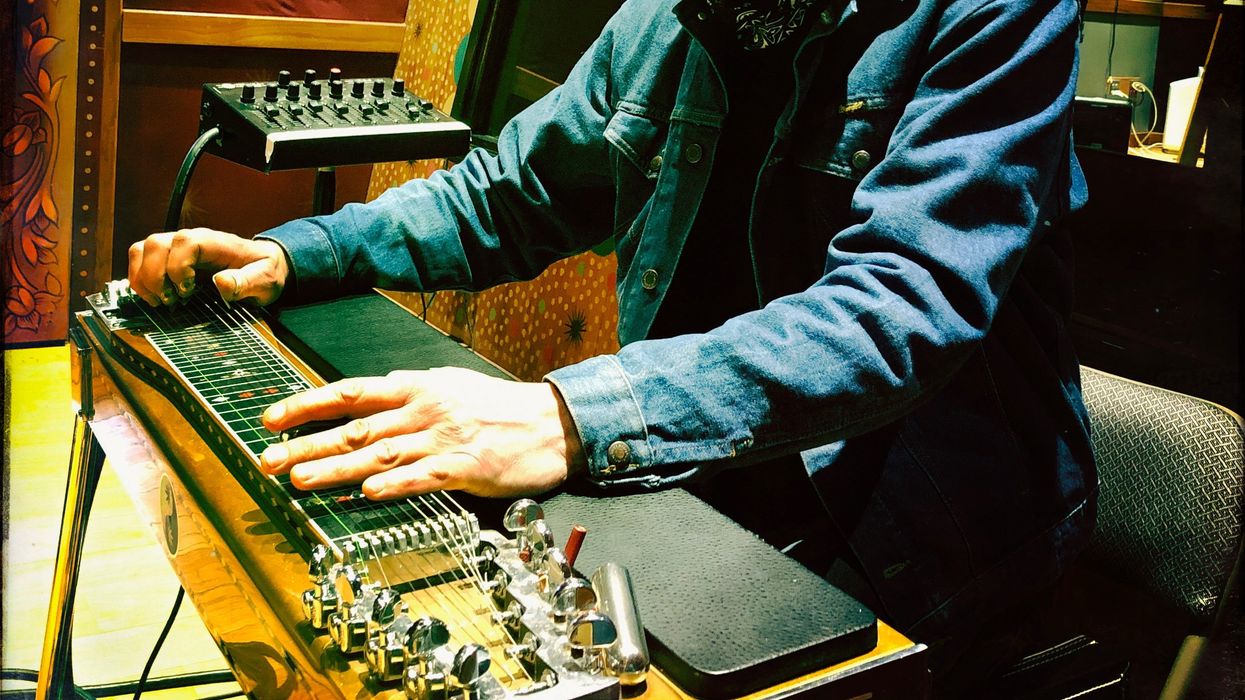
In the 1999 cult classic Mystery Men, Invisible Boy has a superpower that’s as hilarious as it is relatable: He’s invisible, but only when no one’s looking. The moment eyes are on him, he’s just a kid in a cape, exposed and ordinary. Musicians, doesn’t that hit home? When it’s just you and your guitar, the music flows like a river—raw, unfiltered, alive. But flip on the studio’s red light or face a sea of cell phones at a gig, and that river can dry up fast. It’s the red light paradox: The act of capturing inspiration often chokes it.
Players like Marcus King, Masayoshi Takanaka, and Tom Bukovac seem to live in that effortless zone, channeling endless streams of soulful licks. Alone in a room, you might tap into that, too—those late-night jams where riffs cascade and ideas feel infinite. No stakes, no judgment. Only creation. But in the studio, that red light is a judge with a gavel. Every note feels etched in stone, ready for eternal scrutiny. The ticking clock, the producer’s glance, the knowledge that a single take could live forever—it’s enough to stall the flow.
I’ll never forget filming a Rig Rundown with Thom Bresh in 2020. Thom was an absolute legend with talent that drove an incredible seven-decade career. Before we started, I said, “Hey Thom, want to play something going into the interview?” He paused, grinned, and replied, “Been playing my entire life, but the minute somebody asks me to play, I got nothing. My mind goes blank.” If a giant like Bresh could feel that pressure, what hope is there for the rest of us mere mortals? It’s proof that the red light doesn’t discriminate.
“It’s not about nailing every note; it’s about capturing something true.”
Live music, though, is a different beast. There’s freedom in the fleeting moment. The crowd’s energy, the vibe with bandmates, the knowledge that a flubbed note vanishes by the next song—it all invites risk. I’ve seen players, myself included, get bold onstage in ways we’d never try in the studio. You’ll stretch a phrase, chase a wild harmony, or lean into a bend that might not land, because it’s yours and it’s gone in minutes. It’s a tightrope walk with a net, letting you attempt crazier tricks.
In the studio, that net’s gone. The red light means evidence—permanent, unerasable. Every take is a potential exhibit in the court of public opinion. (Even onstage now, since a phone clip can haunt you online until our hypothetical ape overlords unplug the internet.) It makes you play it safe. I do it—sticking to solid takes to avoid being “that guy” holding up the session. If the bassist or keyboardist wants another pass, I’m right there—not always because I hate my take, but for insurance. Just in case there’s a gremlin in the mix—a flubbed note, a shaky vibrato, or a phrase that felt cool but now sticks out like a bad tattoo.
That self-consciousness isn’t just about avoiding mistakes; it’s the weight of permanence. Live, a missed note is usually a blip, forgotten by the encore. In the studio, it’s a ghost that could haunt you. I’ve heard players nail a take only to spend hours second-guessing it, not because it’s bad, but because it might not be perfect. And perfection, we all know, kills vibe. The studio’s a paradox: it’s where you immortalize art, but the process can drain its soul.
”That self-consciousness isn’t just about avoiding mistakes; it’s the weight of permanence.”
So how do you beat the red light curse? Some players treat the studio like a live gig—dim the lights, imagine a crowd, or track live off the floor to capture that loose, communal energy. Others prep relentlessly, woodshedding parts so the light can’t rattle them. Bukovac, in a Homeskoolin’ video, talks about playing like you’re “just messing around,” even in high-stakes sessions. Easier for a guy who bleeds licks, but there’s truth there: The less you fear the light, the freer you play. I’ve tried picturing it as a vibe check, not a verdict, but it’s tough when Thom Bresh’s words echo. Even legends go blank under pressure.
Maybe the answer lies in embracing the imperfection the red light exposes. Live, we forgive ourselves because the moment’s gone. In the studio, we must forgive ourselves knowing the moment’s forever. It’s not about nailing every note; it’s about capturing something true. Next time you’re in the booth, staring down that glowing red eye, channel Invisible Boy. Shrug off the gaze and play like no one’s watching. Because the only judgment that matters is whether the music moves you. If it does, it’ll move someone else, too
“It caters to mass popularity in a way Disneyland does”: Sonic Youth’s Thurston Moore on why major festivals like Lollapalooza have abandoned rock bands

From Jane’s Addiction to Metallica, Lollapalooza has had some iconic rock acts fronting it over the years. However, the last decade has seen a shift towards rappers and popstars, with the 2025 lineup only having one single rock-adjacent headliner in the form of Korn.
So why has Lollapalooza turned its attention away from rock music? In a new interview with Rolling Stone, Sonic Youth’s Thurston Moore insists it’s because society just doesn’t care about rock music any more. “This is the advent of the single popstar surrounded by production, whether it’s dancers and lights and films and stage sets,” he says. “It’s become very sort of Disneyfied, in a way, and it caters to mass popularity in a way Disneyland does.”
The focus is on what’s the most ‘entertaining’ to the average, mainstream music consumer. It’s easier to sell tickets if the line-up is less niche and more broad. Moore notes how the festival is more of a mixed bag nowadays, catering to “the core rock & roll audience that would see Led Zeppelin or Pearl Jam” as well as “people who aren’t that invested in rock music at all, but are invested in entertainment as a broader kind of concept”.
“It has a broader appeal than, say, the standardised rock band,” he notes. “There are still rock bands, but they’re not just playing Lollapalooza.”
He also notes that, right now, rock bands “aren’t the success stories they once were”. Of course, society’s fascination with rock music comes and goes; Beatlemania saw a spike in rock ‘n’ roll buzz, while the early 2000s saw the likes of Linkin Park topping the charts.
Right now, the masses are just loving pop – which, according to Moore, isn’t necessarily a bad thing. “I think all of those musicians are completely credible,” he notes. “Olivia Rodrigo and Chappell Roan are great artists.”
“I just went to see Lana Del Rey, and it was kind of amazing!” he adds. “There was a stage set of a farmhouse, and she was walking in and around it and had dancers everywhere… It was something to see. I liked it. I like her music, and I like what she’s up to aesthetically.”
The mass success of pop acts isn’t negative, either – in fact, Roan and Rodrigo are great role models. “It’s not just crass entertainment,” Moore says. “More power to them. It’s not really my kind of music. And I certainly don’t strive for that kind of mass acceptance at all. I know it would be great for my pocketbook, but other than that…”
However, Moore does believe that the pendulum will swing back. While high-production pop is ‘in’ right now, audiences will soon be craving some gritty and organic. “My predilection is to hear music in a much more intimate setting,” he says. “I like seeing the interaction between musicians that’s very organic. You know, a musician playing guitar that’s plugged into an amp…”
And, of course, underground scenes are still thriving. “There’s still a demographic of young people interested in experimental rock music and anything that comes out of punk culture,” he says. “It’s not Olivia Rodrigo huge… To me, it was always cooler to have a modest kind of existence in that respect.”
While underground scenes might not be given their flowers on the big stages, he does note that a smaller scale of success is sometimes what suits rock ‘n’ roll best. “The big business of rock & roll was a bit of a conflict for somebody like Nirvana’s Kurt Cobain to all of a sudden be in a band that was so massive,” he reflects. “He dealt with it in his own way, and then he didn’t deal with it in his own way.”
Last year, Moore surprised Sonic Youth fans by reuniting with his former bandmates Lee Ranaldo and Steve Shelley for an hour of improvised music at the New York club The Stone. However, there isn’t any serious Sonic Youth ‘reunion’ on the cards. “That was about as much of a reunion as us having dinner together or something,” he laughs.
Outside of his musical work, Moore is also working on his debut novel. Rolling Stone reports that the book is set in the early ‘80s and will navigate the New York music scene. “It’s characters and incidents I certainly felt like I could write about,” he explains.
The post “It caters to mass popularity in a way Disneyland does”: Sonic Youth’s Thurston Moore on why major festivals like Lollapalooza have abandoned rock bands appeared first on Guitar.com | All Things Guitar.
“Music will always be my life but the road is old”: Nikki Sixx thinks being a rock star is “overrated”

After decades of leather, eyeliner, and world tours, Nikki Sixx has decided being a rock star isn’t all it’s cracked up to be.
The Mötley Crüe bassist recently took to social media to share his outlook on the future, including how the whole rock star schtick is now “overrated”.
“Looking forward to these 10 shows with Motley but also extremely excited about all the other projects I have planned for the future not involving being in a band,” Sixx reportedly wrote, according to Ultimate Classic Rock.
The 66-year-old explained that while he still loves performing the band’s catalogue, his priorities have shifted.
“Love playing the songs and honestly most of them are very personal to me but being on the road is not for me for too much longer,” Sixx said. “I have a six-year-old girl to raise and five wonderful older kids and a granddaughter to spend time with.”
The ten shows Sixx referred to are Mötley Crüe’s rescheduled Las Vegas residency, originally slated for March and April this year but pushed back so singer Vince Neil could recover from a medical procedure. The new dates will now run between September to October at Dolby Live at Park MGM.
But while the Crüe still have plenty of unfinished business, Sixx insists the road is no longer central to his life.
“The good news is all these new projects all involve music,” he wrote. “Music will always be my life but the road is old. Being a rockstar is overrated. Being a creative is where it’s at. The future is exciting and the past was a blast.”
Speaking of the past, Mötley Crüe’s upcoming compilation album From the Beginning is scheduled for release on 12 September. The record features a selection of the band’s biggest hits, plus a fresh remix of their 1985 classic Home Sweet Home featuring Dolly Parton.
Check out the full list of rescheduled Las Vegas residency dates at the Mötley Crüe website.
The post “Music will always be my life but the road is old”: Nikki Sixx thinks being a rock star is “overrated” appeared first on Guitar.com | All Things Guitar.
“I’d rather go to a Van Halen party, drink Schlitz malt liquor and get your teeth knocked out”: W.A.S.P guitarist on why he prefers Eddie Van Halen to Randy Rhoads

Chris Holmes knows exactly where he stands in the Eddie Van Halen versus Randy Rhoads debate, and it’s certainly not on the fence.
The former W.A.S.P. guitarist has been accused of having beef with Rhoads – who came up with Quiet Riot in the same LA metal scene in the 70s and 80s – sets the record straight in a new interview, making it clear that while he doesn’t “hate” him, Van Halen will always come out on top in his book.
Speaking with The Metal Voice, Holmes addresses rumours that he disliked the late Ozzy Osbourne guitarist [via Blabbermouth]: “There’s a lot of people [who] say that I hate Randy Rhoads. No, I don’t hate the guy. I like the guy, actually,” he says.
“I think he is a good guitar player. I’ve read on the Internet, a lot of people say I hate him. I don’t hate him. Okay?! He comes from my era, from my age of playing guitar and stuff. I’ve never said I hate the guy.”
Holmes explains that his preference simply comes down to growing up with Van Halen and the energy that Eddie brought to the guitar.
“I grew up with Van Halen,” he says, “so I look at him, who’s better? To me, Van Halen smokes him. So if I go with the Van Halen side of [things]. Van Halen didn’t wear a little bow tie and polka dots. Quiet Riot did. I didn’t like that.”
“I’d rather go to a Van Halen party, drink Schlitz malt liquor and get your teeth knocked out in the mud than go to a Quiet Riot party and smoke Sherman cigarettes and drink Perrier. That ain’t my bag,” Holmes continues. “So it’s different sides of [things].”
“But anyway, yeah, I don’t hate Randy Rhoads. He’s played some good stuff. It’s sad that he died.”
Watch the full interview below.
The post “I’d rather go to a Van Halen party, drink Schlitz malt liquor and get your teeth knocked out”: W.A.S.P guitarist on why he prefers Eddie Van Halen to Randy Rhoads appeared first on Guitar.com | All Things Guitar.
Walrus Audio Qi Etherealizer review – chorus, delay, reverb and glitchy ambient soundscapes all in one pedal

$449/£445, walrusaudio.com
It’s quite possible that people will come to know the Walrus Audio Qi Etherealizer as ‘the Yvette Young pedal’. Especially people who don’t know how to pronounce ‘Qi’. But let’s make one thing clear: this is not an artist signature product.
With her band Covet, Young has become known for her intricately melodic and fluid playing, high on clarity and low on atmospheric excesses. Which means the Qi – combining chorus, delay and reverb with grain-based glitch effects and epic stereo soundscaping – is pretty much the opposite of anything you might call her signature sound.
Okay, so let’s just go along with Walrus and call it a ‘collaborative creation’. But that still leaves the question of why the Yvette Young pedal doesn’t sound like, well Yvette Young?
 Image: Adam Gasson
Image: Adam Gasson
Walrus Audio Qi Etherealizer – what is it?
The best person to explain this contradiction is surely Young herself – which she did back in January when m’colleague Josh Gardner collared her at the NAMM Show, where the Qi (it’s pronounced ‘chee’, by the way!) was launched.
“My overall vision for the pedal was to have something that was an idea generator, an instant vibe,” she said. “I’ve been doing a lot more producing and film-scoring stuff, so I got interested in abstraction. As guitar players, I think we all go through things where it’s like, ‘Oh well, I have my style, I play my riffs…’ I needed something that pushed me and challenged me creatively. And I feel like the granular stuff pushes me in an abstract direction and makes me think in a more painterly way with sound.”
It’s not all about leftfield larks: the reverb and chorus are straightforward enough, while the delay is a simple digital type with no modulation or filtering. But the grain effect is properly radical; there are multiple options for holding down a footswitch to create sustaining beds of sound, and all of this happens in full stereo. Technical math-rockers, brace yourselves: things are about to get bigly ambient.
Tell you what, though… this pedal comes in two finishes: plain black, and a sort of fudgy hue with what appears to be a freshly electrocuted corpse on it. Seeing as Young’s two signature Ibanez guitars come in vibrantly sparkly green or orange, I think we’re allowed to be a teeny bit disappointed with those options.
 Image: Adam Gasson
Image: Adam Gasson
Walrus Audio Qi Etherealizer – in use
First of all, is it easy to turn the individual effects on and off with your feet? No, it is not. In fact it’s virtually impossible – holding down a little push-button is the only option for manual bypass – so bear that in mind if you were thinking of using the Qi as a conventional multi-effects stomper. Actually, there’s so much twiddlability in this 12-knob unit that, unless you enjoy playing the guitar while hunched over like William Blake’s Newton, you might want to consider popping it up on a desk.
And what are those 12 knobs? They’re best understood as four separate columns, each controlling one effect. So, starting on the right, the chorus has mix, rate and depth then the aforementioned push-button, which also lets you switch between tri-chorus and stereo modes; the delay has mix, time and feedback then three time-division options on the button; and the grain has mix, ‘X’ (basically the length of the chopped-up sound slices) and a five-way switch for playback speed, while the button flips between two modes: ‘grain cloud’ (for short glitchy repeats) and ‘phrase sample’ (for longer randomised loop effects).
Same kind of deal with the reverb, then? Not quite – the left column has just a single ‘space’ control for that, and the others are for the pedal’s overall output: wet/dry mix, wet tone, and a button for series or parallel routing.
Now we come to the footswitches… and it’s good news for people with three legs, because there’s a lot going on here. On the left is the master bypass switch, but you can also hit this and the middle one together to scroll through three presets plus manual mode. The right switch is for tap tempo but you can also hold it down to ramp up the delay to maximum feedback; hold down the centre switch to do the same with the reverb, or bop it once to freeze the grain effect.
Can you have the delay, reverb and grain all maxed out at once? Yes. Does this sound vast, spectacular, mystical, magical and potentially hallucinogenic? Also yes. But that’s far from the whole story.
 Image: Adam Gasson
Image: Adam Gasson
Walrus Audio Qi Etherealizer – sounds
You know when you buy a digital pedal and it comes with 200 presets and 196 of them sound like crap? When I am World King, this will be banned. Or maybe just tariffed at 75 per cent, I haven’t decided yet. Anyway, it won’t be a problem for the Qi, because there are only three factory presets (created by Young herself) and they cover the basics very well.
So that’s probably a good place to get started if you’re new to this sort of thing, but for the purposes of this review the first step is to jump straight into manual mode – helpfully indicated by a white LED – for a methodical exploration of each effect.
The chorus gets things off to an extremely promising start, with a sweetly wobbly core sound and lots of flexibility from those three knobs as well as the welcome bonus of the mode button. The stereo effect is suitably luscious, but in a mono setup you might just find the tri-chorus more appealing.
The delay hardly needs discussing, as it’s completely straight and unfiltered unless you choose to attack it with the master tone control – more on that in a sec – while the grain effect is suspiciously similar to the new algorithm on the Walrus Mako Series MkII D1 delay, with the same five options: standard, octave up, octave down, reverse and random (which hops freely between the other four). As on the D1, it’s all quirky but clean and loads of fun.
Finally, the reverb leans towards hugeness and has a tendency to eat everything you put in front of it – even at halfway it will mush out fairly strong delay repeats. Well, this is an ‘Etherealizer’ after all… even so, in the name of balance it’s good to have the parallel option, whereby the four effects are processed separately then summed together at the end.
 Image: Adam Gasson
Image: Adam Gasson
But the best part of this section of the Qi is the tone knob. It might not look like much, but this is a synth-style resonant low-pass filter with a whole lot of sound-shaping muscle. It’s best left fully open to start with, then yanked down for dramatic shifts in and out of darkness – particularly effective when you want to add some movement to an endlessly looping ambience. Speaking of which… let’s start freezing stuff.
Hold down the tap footswitch and the delay takes a few seconds to properly snowball, which it does in a nicely saturated way; it won’t soar and swoop like an analogue type when you start messing with the time knob, but it will make some interesting thwocky noises.
Freezing the grain has a quite different effect, instantly creating a hypnotic loop of pure texture, while maxing out the reverb takes the edge off the granular glitching and turns that loop into a galaxy-sized stereo wash. As a shortcut to ambient nirvana it feels, if anything, too easy – am I still a musician here, or just the pedal’s supervisor? – but where the Qi really excels is in the freedom it gives you to set up a bed of sound and then play around with it.
I mentioned the power of the tone knob earlier; you can also change the grain speed (try going from double to reverse then back again!) and even flip between ‘cloud’ and ‘sample’ modes. Every move adds a new evolution to the soundscape, and brings the kind of unpredictability that might just save you from pseudo-spiritual self-indulgence.
 Image: Adam Gasson
Image: Adam Gasson
Walrus Audio Qi Etherealizer – should I buy it?
In the nicest possible way, this feels more like a toy than a tool. Set up in stereo with a good pair of amps, or a two-channel preamp and headphones, it will eat up whole days of your life as you find yourself creating magical realms of rolling sonic wonder just by picking a few notes and tweaking a few knobs. I don’t think I’ve ever come across a pedal that does this so well, especially in terms of the ability to modify and layer soundscapes once they’re already in flight.
The only caveat, of course, is whether anyone else will ever want to hear these semi-automated creations. I think the answer to that comes down to how you use the Qi – that is, preferably in moderation. The four effects all sound great in normal operating mode, so there’s plenty to explore here without always jumping straight into lushness overload. Please bliss out responsibly.
Walrus Audio Qi Etherealizer alternatives
Is this a multi-effects pedal or an ambient soundscape generator? It’s somewhere between the two, in a zone where you’ll also find the Hologram Chroma Console ($399). For pure brain-swamping reverb you won’t find better than the Old Blood Noise Endeavors Dark Star Stereo ($299/£299).
The post Walrus Audio Qi Etherealizer review – chorus, delay, reverb and glitchy ambient soundscapes all in one pedal appeared first on Guitar.com | All Things Guitar.
A Psychedelic Swirl S-style Honors a Lucky Black Cat
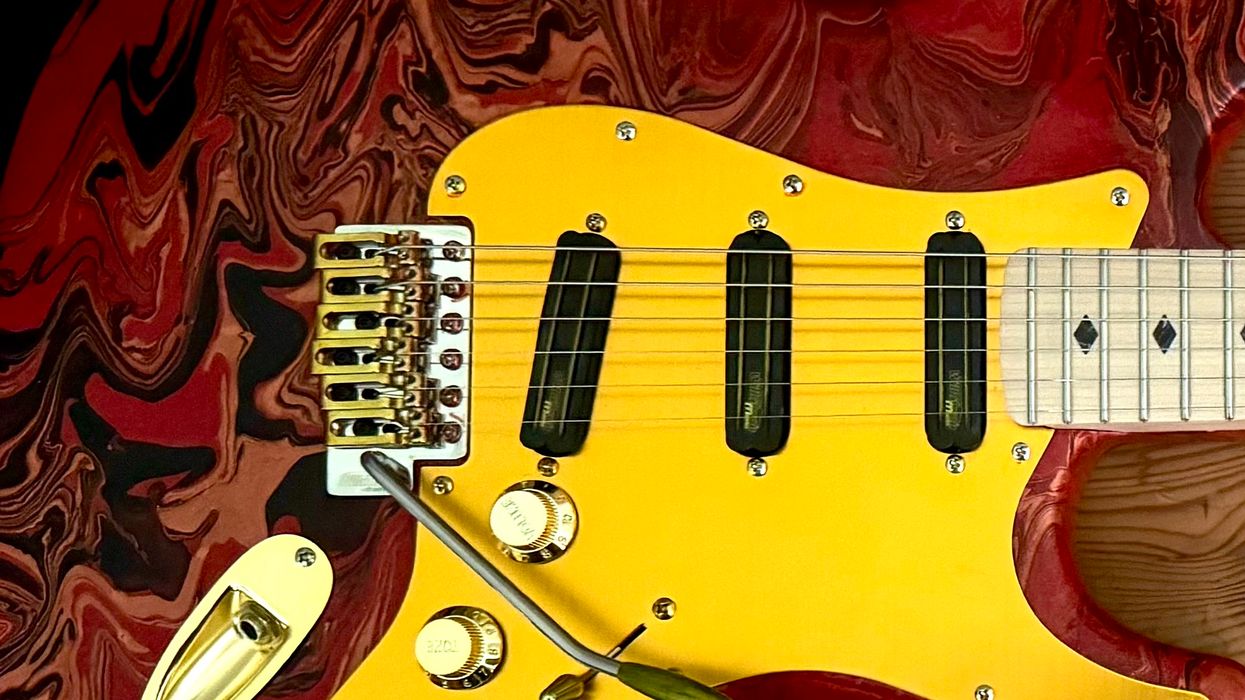
Reader: Cary Cummings
Hometown: Seattle, WA
Guitar: Catocaster
“The problem with cats is they get the exact same look whether they see a moth or an axe murderer.” —Edgar Allen Poe
Leroy had the courage to live on this earth for 19 1/2 years.
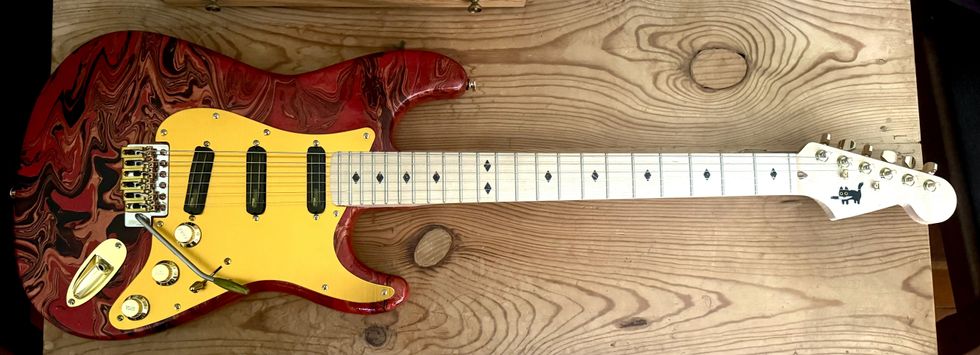
I had no idea what to expect when we arrived at the live animal will-call area at the airport. I knew I was picking up a 12-week-old Burmese kitten. When they brought out his little crate carrier, I was nervous and excited. But when I opened the door to peek inside and greet our new arrival, I saw a shockingly tiny, scared little creature that could fit in the palm of my hand, and I felt so bad that he was put through such an ordeal. He seemed pretty calm about the whole thing.
“Leroy liked flashy things, chaos, and movement.”
At his full-grown eight pounds, Leroy was the patriarch of our household and animal family. Over the course of his days, he lived and played with six different labrador retrievers, outliving three of them. He was everyone’s buddy and tormentor in equal measure. He slept on his bed when he wanted, curled up on a dog’s tummy, or on one of our heads. He loved to play fetch, knock over unattended glasses full of water, and relished a 90 mph sneak attack as we descended the stairs. He loved us, but often reminded us that we really lived in his world and he could take us out at any time. If he had been as big as one of the dogs it would have been terrifying. Sometimes it was terrifying anyway.
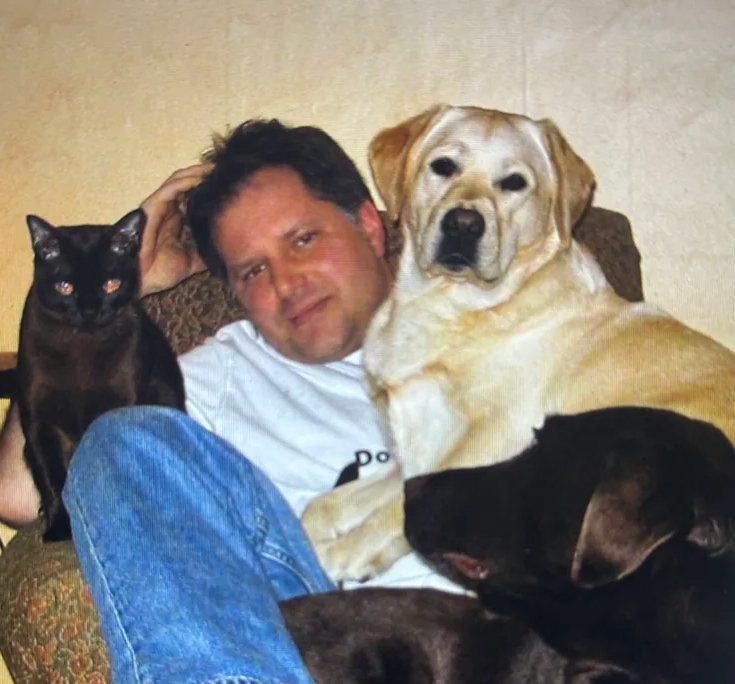
I built this guitar to remember and honor Leroy. He liked flashy things, chaos, and movement. He also loved “helping” change guitar strings and occasionally trying to swallow them. This build consists of a S-style poplar body from Ultratouch Guitars in Texas and a Warmoth quarter-sawn S-style neck with a Clapton carve and 6150 frets. I sprayed the body with a primer coat, followed by apple-red satin, and finished it off with Rustoleum red glitter to give it some sparkle. To add interest and movement, and a little chaos, I dipped it into a 32-gallon garbage can filled with water topped with a swirl of Magic Marble paint, finally sealing it in with 10 coats of wipe-on poly.
The finishing touch included an orange anodized pickguard, Wilkenson/Gotoh VSVG tremolo bridge, Wilkenson low gauss, blade style pickups, 250k CTS pots, 0.015 uF ceramic disk capacitors, Gotoh gold tuners, and a dangerous cat decal on the headstock.
I like to imagine Leroy somewhere over the rainbow bridge playing with his friends: Charlie, Dewey, and Olive. I hope to find them again one sunny day. I know Leroy would approve of this guitar and probably give me another sneaky needle-toothed surprise attack to celebrate.
Rig Rundown Best Of: Legendary Gibson ES-335 Stories and Setups
From Tom Bukovac’s first-year ’58 to Larry Carlton’s iconic ’69 and Molly Miller’s well-worn ’78, this PG best-of Rig Rundown celebrates the artists who made the ES-335 their own. Hear Charlie Worsham’s Vince Gill gift story, Tim Pierce’s player-grade philosophy, and Sturgill Simpson’s stage-shaking tones—plus why so many pros trust this semi-hollow classic.
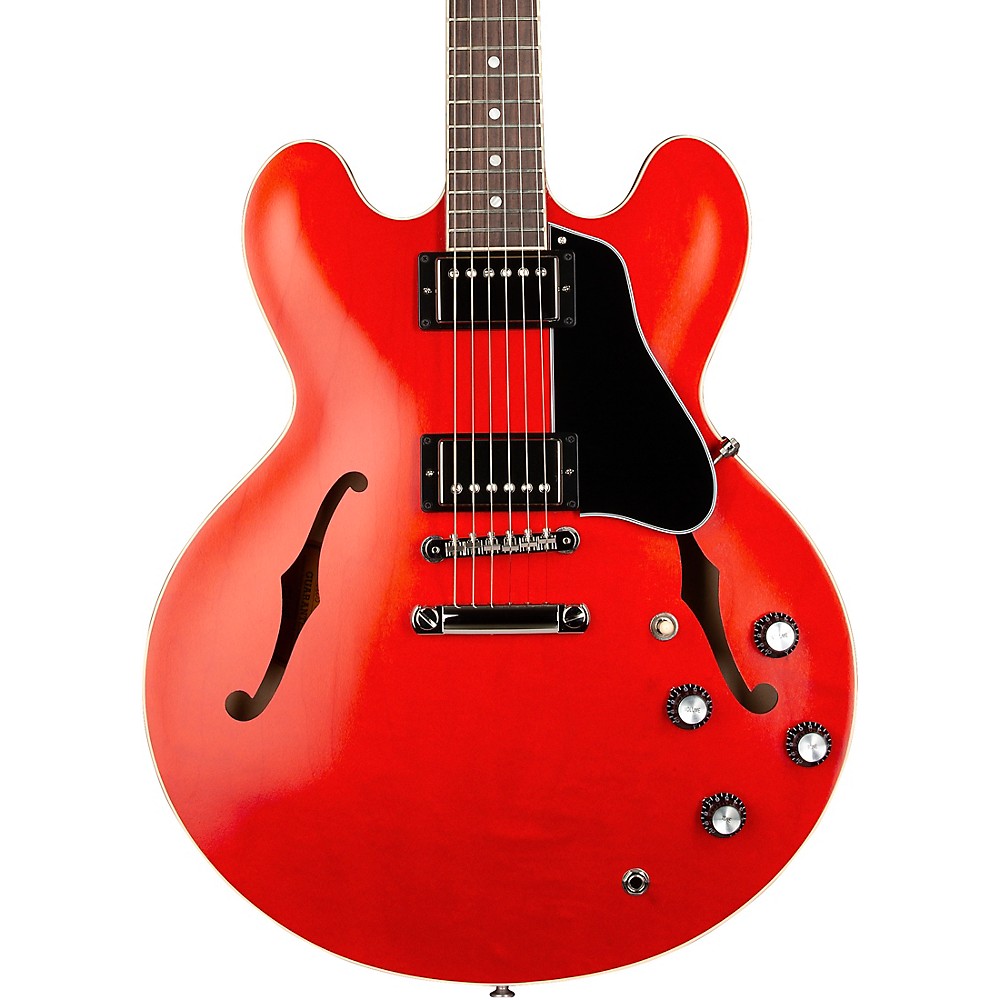
Gibson ES-335 Satin Semi-Hollow Electric Guitar Satin Cherry
Steve Gunn Announces Daylight Daylight; Shares “Nearly There”

Steve Gunn has been at the vanguard of American experimental / guitar-oriented rock music for over a decade. After a trio of acclaimed albums recorded for Matador, Gunn will release his 7th studio record – and first in 4 years – on November 7th.
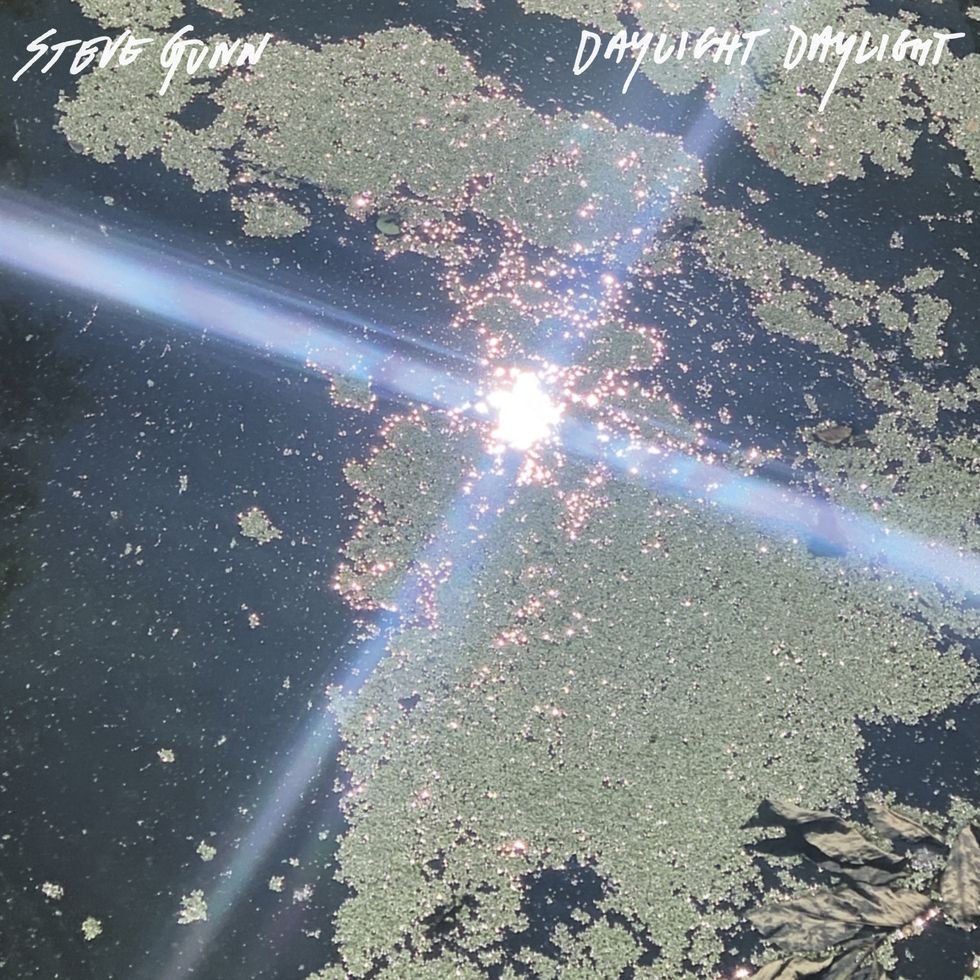
With Daylight Daylight, Gunn wanted to capture something of the intimacy of playing solo, the sense of possibility and discovery that sparks when he sits down to write, while also creating a rich sonic world for the listener to inhabit. Rather than pulling together a band to flesh the songs out, as he’s done on previous albums, he enlisted a single primary collaborator: producer James Elkington, an old friend and longtime collaborator (who also produced Gunn’s 2019 album The Unseen In Between). Elkington is known as a guitarist, but Gunn asked him to contribute arrangements of strings and woodwinds, inspired in part by the music they’ve talked about over the years (ie. Mark Hollis, Ennio Morricone, The Fall, Basil Kirchin) and the evolution of their own relationship making records - both together, and with others. They soon found a fruitful working process for Daylight Daylight: Gunn would record solo demos and send them to Elkington, who had free rein to develop the arrangements on his own. Working primarily out of Elkington’s Nada Studios in Chicago, they would continue adding from there—a whisper of a synthesizer, a guitar overdub, a muted percussion line—but they were committed to the relative spareness of their initial approach. Macie Stewart (violins and viola), Ben Whiteley (cellos), Nick Macri (upright bass) and Hunter Diamond (woodwinds) also contributed. Listen to the album opener “Nearly There” today: noquarter.lnk.to/nearlythere And pre-order Daylight Daylight at the link below: noquarter.lnk.to/daylightdaylight
Tracklisting:
Nearly There
Morning on K Road
Another Fade
Hadrian’s Wall
Daylight Daylight
Loon
A Walk
Gunn will tour the UK and Europe in October and November and is announcing a run of US dates today.
Sept 11 – Chicago, IL @ Sound & Gravity Festival
Sept 25 – Kingston, NY @ Tubby’s Oct 23 - London, UK @ St. Mathias *
Oct 24 - Glasgow, UK @ Hug and Pint *Oct 25 - York, UK @ The Band Room *Oct 26 - Shropshire, UK @ Firefly *
Oct 28 - Stockholm, Sweden @ stadsgardsterminalen
Oct 29 - Göteborg, Sweden @ Pustervik
Oct 30 - Oslo, Norway @ Bla
Oct 31 - Kristiansand, Norway @ Dirty Old TownNov 1 – Stavanger, Norway @ Folken
Nov 2 – Bergen, Norway @ Kunsthall
Nov 9 - Sétubal, Portugal @ Forum Luisa TodiNov 14 - Dranouter, Belgium @ Dranouter
Nov 15 - Turnhout, Belgium De Warande
Dec 3 – Philadelphia, PA @ Johnny Brenda’s
Dec 4 – Baltimore, MD @ Metro
Dec 5 – Raleigh, NC @ King’s
Dec 6 - Washington, DC @ DC9
Dec 10 – Portsmouth, NH @ The Press Room
Dec 11 – Portland, ME @ Space
Dec 17 – New York, NY @ Le Poisson Rouge
Jan 1 – Sawyer, MI @ Out There
Han 14 – Seattle, WA @ The Triple Door
Jan 15 – Vancouver, BC @ The Fox Cabaret
Jan 17 – Portland, OR @ Polaris Hall
Jan 20 – San Francisco, CA @ Café Du Nord
Jan 21 – Santa Cruz, CA @ The Crepe Place
Jan 22 – Ojai, CA @ Deer Lodge
Jan 23 – Los Angeles, CA @ The Lodge Room
Jan 25 – Pioneertown, CA @ Pappy’s & Harriet’s
*w/ James Elkington
Tame Impala Releases New Single “Loser”
Today, Tame Impala (Kevin Parker) unveils “Loser,” the second song of this new era. LISTEN HERE. The track continues Parker’s fearless exploration of rhythm, texture, and sonic experimentation, building on the meticulous studio approach that has defined his career. The single is accompanied by a music video directed by KRISTOFSKI, and starring actor/musician Joe Keery (Stranger Things, Fargo). Watch the clip HERE:
Prior to today’s release, Parker gave fans a taste of what’s to come with the release of his sprawling, drum-beat heavy “End of Summer.” It drew listeners back to the acid house summer of ’89, free parties of the mid-90s, and Australia’s bush doofs in outback paddocks. “Loser” continues Parker’s journey into new sonic territory, layering hypnotic rhythms and textures that push Tame Impala’s sound ever forward. Drawing from a rich history of dance music, his work transforms the imagined past into a sound that feels both present and eternal, reaffirming Tame Impala as one of modern music’s most visionary acts.
Kevin Parker has emerged as one of the most influential voices of the last decade. A singular artist renowned for carving out a distinct sound all of his own, Parker crafts transcendent genre-bending sonic landscapes playing every instrument and acting as writer, producer, mixer and engineer on his projects. He has been nominated for four GRAMMY awards with one win for his collaboration with Justice on 2024’s “Neverender.” In his home country of Australia, he’s racked up an impressive 13 ARIA Awards and 27 Nominations. He’s won the BRIT Award for Best International Band and scored nominations for two Billboard Music Awards and an American Music Award. Tame Impala has had numerous US Alternative Radio Top 10 songs including two #1’s for “Lost In Yesterday” and “Is It True.” Tame Impala’s “The Less I Know The Better” is part of the Billionaires Club with over 2 billion streams and the project has racked up numerous gold and platinum certifications globally.
Tame Impala has headlined festivals and arenas around the world and released four full length albums - InnerSpeaker, Lonerism, Currents and his most recent album The Slow Rush. The Slow Rush landed at #1 in multiple territories and was his highest charting album to date in both the US and UK, with 14 top 10 chart positions around the world. As a writer and producer Parker has collaborated with Dua Lipa, The Weeknd, SZA, Lady Gaga, Travis Scott, Mark Ronson, Gorillaz, Thundercat, Kali Uchis, 070 Shake, Rhianna, Miguel, A$AP Rocky and many more.
Jimi Hendrix Sonic Scholar Andy Aledort | 100 Guitarists Podcast
We figure Jimi Hendrix is easily the most discussed guitarist of all time. And at this point, there are probably few, if any, stones left unturned. So for our Hendrix episode of 100 Guitarists, we had to go to the ultimate scholar on Hendrix’s playing to get deep, and luckily we knew just who to call.
Whether you realize it or not, you’ve probably learned at least a song or two from a transcription or lesson by Andy Aledort. A veteran guitar journalist and transcriber whose resume stretches back to the earlier days of guitar magazines, he’s released books and DVDs teaching the secrets behind Hendrix’s playing and continues to post on YouTube. And if that’s not authoritative enough, Andy has not only played with the Band of Gypsys, but he’s one of the guitarists that Buddy Miles and Billy Cox called for the recording of their The Band of Gypsys Return record.
On this episode, Andy walks us through his own experience of Hendrix’s music, plays us some examples, and tells us some stories from the early days of guitar journalism.
Thanks to our Sponsor, Strings by Mail!

Learn More stringsbymail.com
Podcast 515: Ryan Richter, Dylan Day, and Harrison Whitford (Live from the 2025 Fretboard Summit)
Ryan Richter, Dylan Day, and Harrison Whitford are three wildly creative guitarists who happen to play with some of the most-streamed artists of the last few years, including Ed Sheeran (Dylan), Phoebe Bridgers (Harrison), and Lizzy McAlpine (Ryan). They are all based in Los Angeles.
At the 2025 Fretboard Summit, we sit down with these three musicians to discuss their journeys as artists and collaborators. We hear about why they all landed in LA, how they work with big-name artists, the gear they are currently obsessing over, their solo recordings, and so much more. It’s an introspective chat filled with insights.
https://www.instagram.com/dylnday/
https://www.instagram.com/misterrichter/
https://www.instagram.com/scarrisonwhitford/
Our next Fretboard Summit takes place August 20-22, 2026 at the Old Town School of Folk Music in Chicago. https://fretboardsummit.org
We are brought to you by: Stringjoy Strings: https://stringjoy.com
(Use the code FRETBOARD to save 10% off your first order)
Mike & Mike’s Guitar Bar: https://mmguitarbar.com
Peghead Nation: https://www.pegheadnation.com (Get your first month free or $20 off any annual subscription with the promo code FRETBOARD at checkout).
Subscribe to our reader-supported print magazine: https://www.fretboardjournal.com
Above: Jason Verlinde interviewing Harrison Whitford, Dylan Day and Ryan Richter at the 2025 Fretboard Summit. Photo: Sofia Wolfson
The post Podcast 515: Ryan Richter, Dylan Day, and Harrison Whitford (Live from the 2025 Fretboard Summit) first appeared on Fretboard Journal.
EBMM End Of Summer Sale
For a limited time, enjoy special savings on select Music Man guitars and basses, including some of our most popular and in-demand models. These deals won’t last long! Sale ends October 8th..
Participating Dealers:

American Music Supply Collection

ZZounds Collection

Sweetwater Guitar Collection
Sweetwater Bass Collection


The Red Light Trifecta
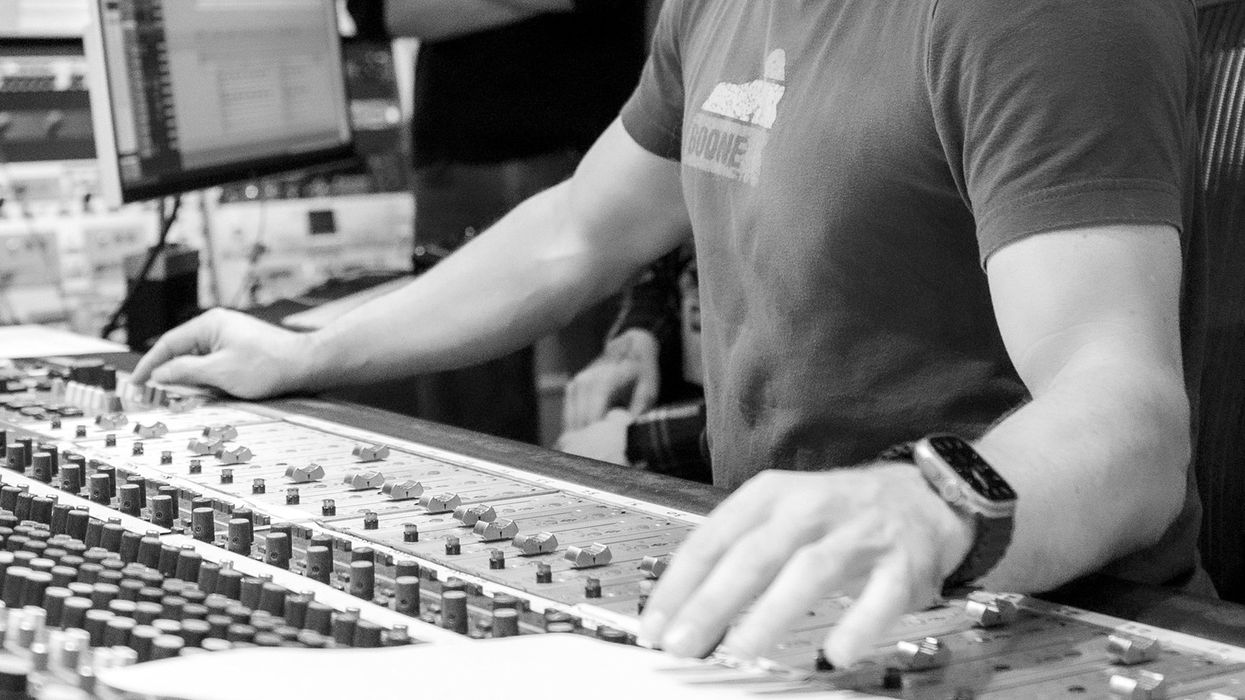
Player feel, mic placement, and your recording room are the real secrets to getting soulful, compelling performances. Spend time understanding them before you push the button.
In a world saturated with plugins, presets, and post-production wizardry, it’s easy to forget the most important part of the recording process. I call it the “Red Light Trifecta.” It’s a simple, powerful concept that can transform your recordings from sterile to soulful—regardless of your gear, your room, or your budget. Tighten up your belts, the dojo is now open.
The Red Light Trifecta refers to three interdependent elements that define every recorded sound: the player (of which the instrument is merely an extension), the microphone (and its placement), and the room. If you’re lacking in any one of these, your recording suffers—not just in fidelity, but in feel. When all three work in harmony, the red light on your recorder becomes a doorway to magic. Below, we’ll explore the steps to achieving this.
1. Feel First, Gear Second
It’s easy to get lost in the gear conversation. The internet is full of passionate debates about preamps, converters, boutique mics, and vintage/new guitars. But none of it matters if the performance isn’t compelling.
When you press record, you’re not capturing a tone; you’re capturing a human being’s interaction with an instrument. You’re capturing intention, emotion, and energy. The touch of a player’s fingers on the fretboard, the timing of a right-hand mute, the bend at the end of a phrase—these micro-decisions are what form the soul of a recording. And they’re specific to that player.
“When you press record, you’re not capturing a tone; you’re capturing a human being’s interaction with an instrument.”
If you’ve ever plugged into someone else’s rig—same guitar, same amp, same settings—you know how uncanny it is that you still sound like you. Conversely, a truly great player can make a pawnshop guitar sound like it came from a boutique luthier’s bench. That’s not mysticism; it’s muscle memory, control, and mindset.
So the first rule of recording is this: Start with the player (even if it’s you)! Are they connected to the music? Are they playing with purpose? No amount of EQ or compression can fake that.
2. The Mic: Placement Over Price Tag
If the player is the heart of the performance, the mic is the conduit. There are thousands of microphones out there; some with reputations so mythic they practically glow in the dark. But a great mic in the wrong place will still result in a lousy recording. Conversely, a modest mic in the right spot can yield professional, even breathtaking results.
Mic placement is where your ears matter more than your eyes. It’s about experimenting, listening, and adjusting. Moving a mic an inch can dramatically change the tone—less boom, more clarity, tighter low end, softer transients. You’re not just pointing a mic; you’re sculpting a sound at the source.
Want a quick way to test your placement? Record a short passage, then move the mic slightly and record again. Compare. Listen to not just the tone, but the space, the balance, the emotional impact. Don’t be afraid to break rules or try unconventional setups. Your job isn’t to copy someone else’s sound—it’s to find the best version of yours.
Remember: It’s very easy to make an expensive mic sound cheap. But with care, it’s also possible to make a budget mic sound exceptional.
3. The Room: The Invisible Instrument
The third member of the trifecta is the most misunderstood—and the most revealing: the room. Every space has a sound, whether you’re aware of it or not. Some spaces are flattering. Some are brutal. But all of them are recorded.
Think of the room as your invisible instrument. It contributes resonance, reflections, and tone. It shapes the reverb tail, the attack, and the decay. If the room is boomy or boxy, your track will sound that way—even before you add any processing. If it’s too dry, you might find your recordings feel lifeless or anemic.
That doesn’t mean you need a world-class studio with floating floors and golden ratios. It means you need to understand your space. Clap your hands. Walk around while playing. Record from different spots. Learn what your room wants to do naturally and work with it, not against it.
Sometimes, the best solution is to change the instrument’s location by a few feet. Or use furniture as gobos. Or hang a blanket. Or lean into the room’s quirks and let them define the character of the track.
The Trifecta in Action
When all three elements align, you get a vibe. You get a performance that resonates emotionally, and sonically. And in the end, that’s what we remember: not the mic model or plugin chain, but how the music made us feel. Until next month, namaste.


